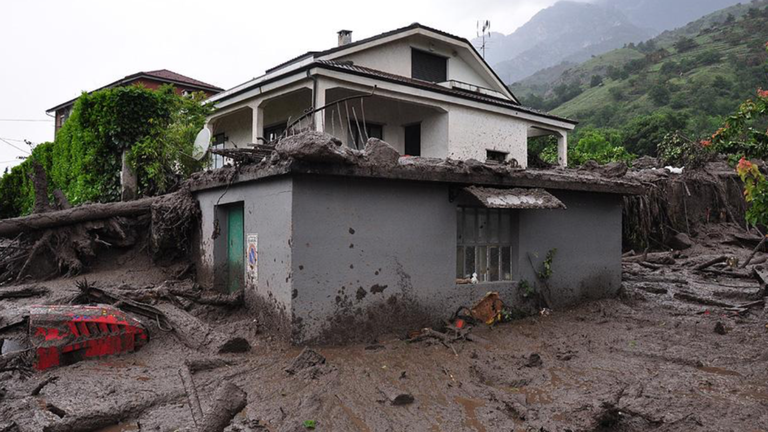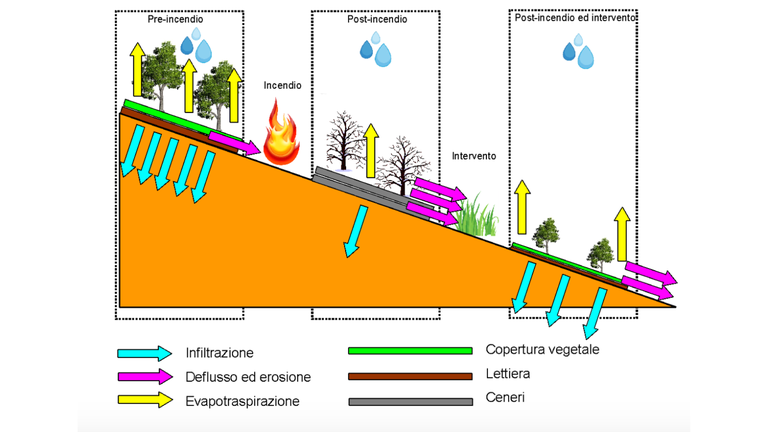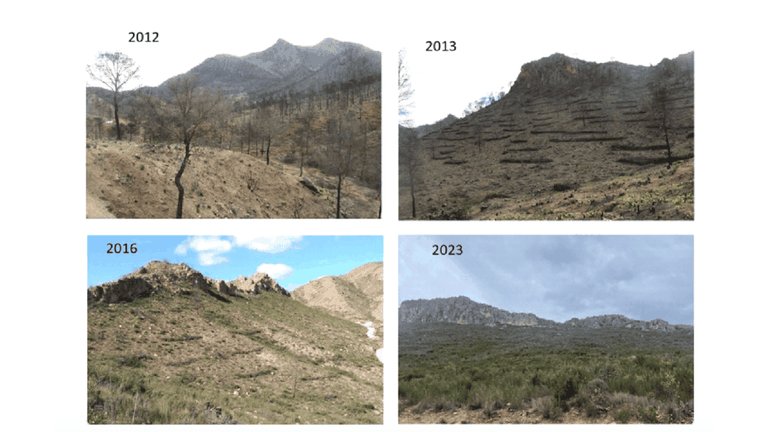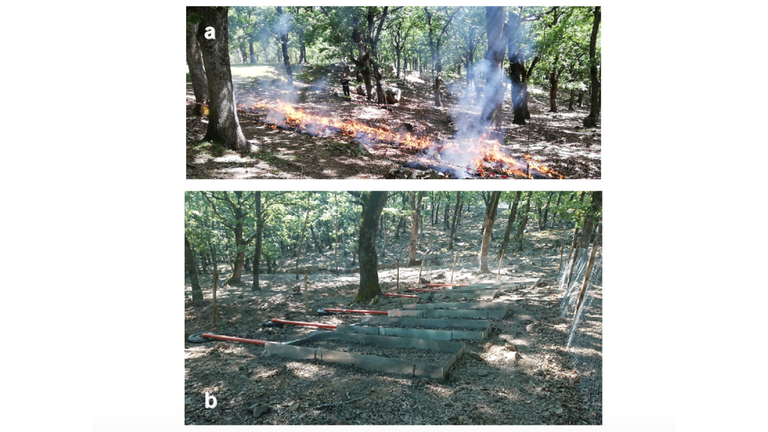https://www.lifegate.it/incendi-boschi-dissesto-idrogeologico
- |
On 7 June 2018, after lunch, some citizens of Bussoleno, in the lower Susa Valley, will have thought about Dolcenera, the song by De André who sings about the "black water that takes away", about "bad luck" and "bitter strata", seeing the flow of debris fall from the mountains towards the streets of the city, dragging trunks, boulders, then cars , garden gates and children's slides.The weather, made unstable by a Mediterranean depression full of cold air at high altitude, had resulted in a localized and intense storm, which had remained in the mountains of Bussoleno.That day those forest-covered mountains, which for centuries have protected the city from falling rocks and avalanches, poured over the country from 15 thousand to twenty thousand cubic meters of debris.

Was it due to climate change?It is difficult to demonstrate with certainty the link between global warming and a single storm, however intense and localized.However, the climate crisis played a role in Bussoleno a decisive role.At the end of August 2003 Central Europe and the Alps were hit by one heat wave which broke all historical records.In those days, in the mountains of Bussoleno, an unprecedented summer fire he had travelled five hundred hectares of beech forests, a forest species rarely affected by fire.Yet the forest was able to recover spontaneously after a few years, given that the trunks remaining on the ground, although burned, had protected the soil from erosion and created the conditions for the regrowth of vegetation.But in October of 2017 a new fire it burned approx four thousand hectares of forest, consuming all the logs accumulated after the 2003 catastrophe and "cooking" the soils of the slopes above Bussoleno as if in a furnace at 1200 °C.A few months later, in June of 2018, the debris flow on the town of Bussoleno reminded many not only of "Dolcenera", but of the real danger that the climate crisis entails and the unpredictable risks with which it manifests itself.
Fires make forests more vulnerable to water erosion
Normally, the forest modifies the movement of the water and sediments along a slope.The leaves intercept raindrops and dissipate humidity throughevapotranspiration, while the forest soil favors the infiltration of water in depth.Consequentially the action of the trees generally reduces the quantity of water that flows down the slope and is conveyed into the downstream hydrographic network.Since surface runoff, together with the impact of rain, also increases erosion, with loss of soil from the slopes and transport of sediments in the hydrographic network, the presence of the forest contributes to retain fertile soil and reduce erosion and solid transport in waterways.The effectiveness of the forest in the hydrological balance depends on numerous factors, including the physical characteristics of the soil, the slope of the slopes and the management or degradation actions of the forest (for example soil protection interventions, the deforestation, The fires, theurbanization).On average, a forest reduces runoff and surface erosion by 15-30 percent compared to pasture or agricultural land with similar soil and slope.
When a high intensity fire hits a forest and eliminates part of the plant cover, runoff and water erosion immediately increase.Such increases can aggravate flood phenomena in urban and peri-urban areas downstream of burned forests, causing damage to people and infrastructure.The severity of these consequences depends on theintensity of the fire:for low intensity fires the impact on tree cover is limited, while in severe fires the trunks and crowns are almost completely burned and the soil can reach very high temperatures (up to 600-800 °C).On the one hand, the removal of litter and vegetation reduces interception and evapotranspiration, thus increasing the amount of rain that turns into surface runoff.On the other hand, the soil, deprived of the protection of vegetation, is more vulnerable to erosion determined by rain and water flow.Finally, the heat released by the fire modifies the properties of the soil, consuming part of the organic substance and making the soil partially waterproof, therefore less capable of letting water infiltrate.Ash can clog the pores of the soil, making it more impermeable, and can be transported from slopes to waterways.
In the first year after the fire, soil loss in Mediterranean areas it can reach values of the order of 50-60 tonnes per hectare, an erosion rate five-six times greater than the tolerable values in rural areas.After a certain period, from a few months to several years, depending on the intensity of the fire, runoff and erosion tend to return to pre-fire values, thanks to the spontaneous recovery of vegetation and the more or less complete disappearance of soil alterations.

Luckily, it is possible to reduce the impacts of fire and accelerate the return to pre-fire hydrological conditions.The USA, theAustralia and, to a lesser extent, Spain And Portugal are the pioneer countries in the so-called "post-fire management” in a forest environment, i.e. in the application of interventions soil conservation, Of forest regeneration and of prevention of future fires even over very large areas after the fire has passed. Interventions such as reforestation, sowing, mulching, tillage and construction transversal structures their objectives are the restoration of vegetation, the elimination of residual fuel, the protection of the soil from the erosivity of rain and water currents and the reduction of sediment transport to valley areas.It's possible too intervene in waterways building small barriers to retain the sediments transported by the current and delay the propagation of floods.

How "post-fire management" works on forest soil affected by the fire
- The reforestation increases plant cover and improves the hydrological properties of the soil affected by fire.However, forest seedlings have need time to grow:several years are needed to completely restore the pre-fire vegetation cover.You also have to choose tree species carefully to plant:some, such as pines, increase the water repellency of the soil, while the planting of highly flammable trees increases the danger of future fires.
- There mulching (mulching) consists of applying organic materials (straw, leaves, shredded bark, shavings) to the surface of the soil in quantities approximately between one and ten tons per hectare.If practiced correctly and promptly, mulching significantly reduces surface runoff and soil loss, as well as improve soil quality thanks to the supply of organic substance, nutrients and minerals.A treatment that covers eighty percent of the soil can reduce surface runoff by over fifty percent and soil loss by eighty-ninety percent compared to untreated areas.Furthermore, both the applied material and the vegetation that develops increase humidity, reduce evaporation and mitigate temperature changes in the soil.Thanks to these effects, the mulching è become one of the most widely used post-fire soil conservation techniques globally.Organic residues are easily found in rural environments and are easy to handle, so treatments are low cost.Sometimes, residues can be distributed by agricultural machinery or helicopters, allowing large burned areas to be treated relatively quickly.Some disadvantages, such as the danger of introducing parasites to the forest plants or the dispersion of material by the wind, can be limited by using forest residues coming from the forest itself, for example wood chips, although higher doses must be distributed.
- The transversal structures they are built with inert materials, gravel or stone, or wood, arranging burnt or unburned tree trunks in a direction perpendicular to the maximum slope of the slope.These structures they act as barrier to the flow of water and sedimenti, retaining up to forty percent of the solid material with a long-lasting effect and low economic commitment. After about ten years from the fire, these interventions allow an almost total restoration of the ecological conditions and the good hydrological "functioning" of the soil, provided that adequate maintenance of the structures is guaranteed in the medium-long term.

- The soil cultivation techniques, for example terracing, are aimed at modifying the morphology of the slopes, the properties of the soil and increasing infiltration, but are generally less effective than other post-fire treatments.It is therefore advisable to adopt these techniques in combination with other treatments to increase its effectiveness.Other techniques involve the use of nets, mattresses or rolls of natural fibers to support the regrowth of vegetation and the stabilization of the soil on slopes affected by fire.
- There bridle construction in watercourses it reduces the speed of the current and favors the deposition of sediments transported by the flood.In smaller watercourses the bridles are made with straw bales, wood or stone (loose or arranged in gabions), more rarely in concrete.However, the effectiveness of this technique it is not optimal, since the dams are permeable to fine sediments and ash and are subject to failure.Furthermore, the storage capacity of the material tends to run out within a few years after the fire.
Certainly prevention is better than cure.Avoiding the ignition and spread of forest fires is the most effective and least expensive strategy to avoid hydrogeological instability.For example, it can be adopted as prevention technique fires the so-called prescribed fire, which consists of the expert and planned application of fire to vegetation.That is, precise requirements are adopted that allow the impacts to be minimized and management objectives to be achieved, such as reducing the quantity of flammable material in the event of a fire.The technique, commonly used in several countries, is becoming established also in Italy as one effective tool for the prevention of forest fires.Prescribed fire transmits a limited amount of heat to the ground and therefore does not induce significant alterations in its properties, as in the case of intense fires.However, in particularly intense applications runoff and erosion phenomena can worsen.In these cases an effective strategy consists of combine prescribed fire operations with timely mulching with plant residues, at least in the steepest areas.A recent one investigation in Calabria highlighted that the soil treated with prescribed fire and subsequently covered with mulching Of fresh fern (easily found in the undergrowth) can reduce runoff by twenty percent and soil loss by almost eighty percent compared to burned but untreated areas.

THE computer models for the prediction of future climate changes predict an increase in the duration of the drought, from the average temperatures and of therainfall intensity on a planetary scale, at least for the next eighty years.This will aggravate both the risks of fire and those of floods and hydrogeological instability.They will then be prevention techniques are increasingly necessary of forest fires to limit the areas where serious hydrological and geological risks can arise, and soil conservation strategies in forests affected by fire.Timely and effective intervention can prevent damage from flooding, landslides and erosion, mitigating the dangers to people and infrastructure in areas downstream of burned forests: an investment and necessary care For protect the forests from natural threats, such as extreme rainfall, and anthropogenic, such as arson or negligent fires.These dangers, if not addressed, risk deprive ourselves of the indispensable heritage of biodiversity and of ecosystem functions to support our survival.
